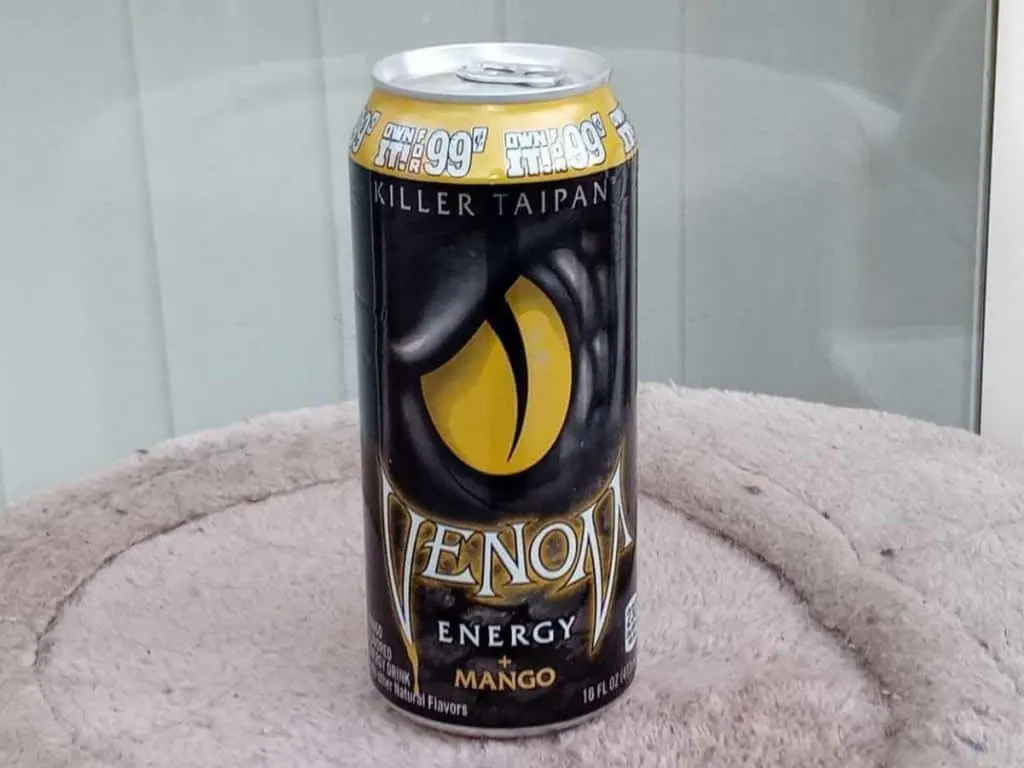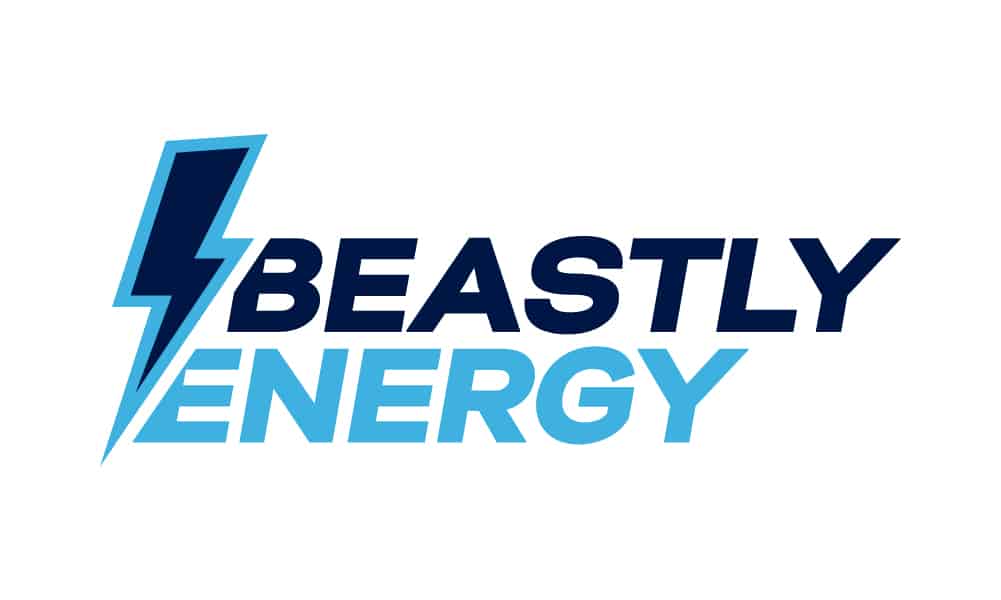Venom Energy drink is known for the menacing reptilian eye staring back at you , as if daring you to take a sip. But while the packaging does indeed look dangerous, can we say the same for its contents?
Nutrition facts are important because they reveal a product’s forbidden secrets, secrets that can either make or break your health. So today we will be looking at Venom’s nutrition facts and whether it’s safe to drink or not.

So what can Venom’s nutrition facts tell us about the product? Is it healthy, or otherwise?
Long story short, Venom is basically 100% sugar, which is not exactly earning it any medals in the health department. One can contain a whopping 54 grams of added sugar, the highest I’ve seen in any energy drink I’ve ever come across.
Keep reading as we dive in deeper to the nutrition facts of Venom.
Contents
What is Venom Energy Drink?
Venom is an energy drink that was first launched in 2002 by Dr. Pepper Snapple Group/Keurig Dr. Pepper of Plano, Texas.
Dr. Pepper Snapple Group/Keurig Dr. Pepper states that Venom energy drinks are for people who want to experience thrill-seeking adventures and provides the bite that hard-core energy drink fans demand.
Venom has ingredients like caffeine, l-carnitine, guarana, ginseng and taurine, which is considered to be the hard core ingredients that avid energy drink consumers are looking for when it comes to beverages that give them energy.
Why Are Nutrition Facts Important?
The purpose of nutrition facts is to guide you (consumers) and help understand what you’re putting in your body and to be able to make healthier choices.
With nutrition facts, you can determine whether the amount that a food/beverage contains is too much or just sufficient for your nutritional needs — that’s why foods and beverage companies are required by the FDA to provide nutrition labels for all their products.
You can use nutrition fact labels to find foods/beverages that have a high amount of vitamins, fiber, and protein.
I also want to emphasize that if you have health conditions such as high blood pressure or high cholesterol, then reading the nutrition facts label is a no-brainer.
What Should I Look for When Reading Food Labels?
There are several things you need to look out for when reading nutrition labels. The most important are the calorie content, the total fat, the total carbohydrates, the added sugar, as well as the vitamins.
This may be an article about Venom Energy, but the same can be applied for just about any pre-packaged food or drink you happen to come across as well, so here are some tips for you to read nutrition facts label effectively and what mistakes you can avoid when reading the nutrition facts:
- Don’t only look at the calorie content. Why? It’s because if the food/beverage has 200 calories yet it has 2.5 serving per container, that means the food/beverage actually has 500 calories!
- When you see fats in nutrition fact labels, it’s not necessarily bad. The fats you should avoid are trans fat since it increases your LDL (bad) cholesterol and lowers your HDL (good) cholesterol. Saturated fats are only bad when not taken in moderation, too much of it can also raise LDL (bad) cholesterol and negatively impact the heart.
- Keep in mind that not all fats are listed on the nutrition facts label, only the nutrients considered most important ever make it to the nutrition labels. The other fats that aren’t included are generally healthy, but you can read about all types of fat here if you want to know about it.
If you want to know more about reading the nutrition facts label, you can watch it here. An image below shows an example of how a nutrition facts label looks like from the back of the can of Venom:

Nutrition Facts of Venom Energy Drink
For you to read it easier, I made a table to show the nutrition facts of Venom and the amount it contains:
| Typical Value (Standard Serving) | Venom (16 fl.oz) |
| Energy | 230 calories |
| Protein | 0 g |
| Carbohydrate (Of which Sugars) | 57 g (54 g) |
| Sodium | 300 mg |
| Caffeine | 160 mg |
| Vitamin B2 (Riboflavin) | 3.2 mg |
| Vitamin B3 (Niacin) | 36 mg |
| Vitamin B5 (Pantothenic Acid) | – |
| Vitamin B6 | 4 mg |
| Vitamin B12 | 12 μg |
Venom Energy Caffeine Content
Out of all in the nutrition facts label, caffeine is the most important. It blocks adenosine receptors which simply means that caffeine prevents you from feeling sleepy and tired – you can feel the effects of caffeine within 30 to 60 minutes of consuming it.
According to Science Focus, studies have found that the effects of coffee and cola (both have caffeine) can be felt only just after 10 minutes, but its peak is said to be felt after 45 minutes.
However, caffeinated tablets take much longer to reach their peak which is around 60 and 75 minutes – even if the dosage is equivalent to coffee and cola.
Mayo Clinic suggests that only 400 mg of caffeine should be taken in a single day. Exceeding that amount can lead to side effects like:
- Anxiety
- Insomnia
- Digestive Issues
- Muscle Breakdown
- Addiction
- High Blood Pressure
- Rapid Heart Rate
- Fatigue.
The caffeine content of venom is 160 mg which is higher when compared to other energy drinks like Red Bull. Although it doesn’t exceed the limit of caffeine intake, you should only drink one can of Venom to maintain your healthy lifestyle.
Venom Energy Sugar Content
Everybody loves sugar, but our body suffers from the bad sugar’s detrimental effects. If you noticed that I said bad sugar, that’s because there are good sugars and bad sugars.
As a simple rule, good sugar is found in whole, unprocessed foods such as fruit, vegetables, legumes and whole grains (4). Bad sugar is the “added” sugar that we put in our coffee, use in baking and hide in sauces, ready-made meals and sweet drinks like pop (5).
But what makes good sugar good and bad sugar bad?
One answer has to do with the nutrients-per-calorie ratio, i.e. how many nutrients are you getting per calorie? Added sugar comes with a significant amount of calories but relatively no nutrients. Fruit and vegetables, on the other hand, come with less calories and amazing essential nutrients such as vitamins, minerals, amino acids, antioxidants and fibre that are vital to our health (6).
The presence of fibre is key, because it slows down the absorption of sugar into our bloodstream. When you consume added sugar, there is nothing to slow this process down. This speedy absorption can lead to an unhealthy spike in your blood sugar (7).
Green Moustache
The American Health Association (AHA) suggests that if you consume added sugar, you should limit it to only 100 calories per day (about 6 teaspoons or 24 grams of sugar) if you’re a woman.
For men, the suggested intake of added sugar per day is 50 calories per day (about 9 teaspoons or 36 grams of sugar).
Keep in mind, that your body does not benefit from added sugars since it has no nutritional value – it just makes our food/drink taste better.
Sadly, Venom has too much sugar for anyone, which does not make it an ideal drink, but that doesn’t mean you can’t drink Venom. I suggest exercising and having a balanced diet, to prevent Venom from having too much of an impact on your diet.
Venom Energy Calorie Content
Calories are a unit of energy used to determine how much energy a food/beverage can give you.
Our body uses energy for just about anything. It can also be used to maintain essential body functions, such as cell growth and repair, respiration, and blood transportation.
Venom has 230 calories per 16 fl.oz, which doesn’t sound like a lot, but do remember that the Dietary Guidelines for Americans ranges the daily caloric intake at 1,600 and 2,400 calories a day for women and 2,000 to 3,000 for men.
As such, a can of Venom constitutes nearly 1/10th of your overall daily caloric intake, so be sure you know what you’re getting into before downing the can, and keep in mind that the recommended intake still depends on your age, size, height, lifestyle, overall health, and activity level.
Venom Energy Drink Sodium Content
You shouldn’t confuse salt with sodium:
- Sodium is what’s usually found in food like processed foods that contains preservatives
- What we add to our food is salt
It’s advised that you shouldn’t consume more than 2300 mg of sodium per day. Consuming too much can lead to high blood pressure, heart disease, and stroke.
If you want to reduce your sodium intake, choose unprocessed foods like fruits and vegetables since they’re low in sodium. Most of the sodium we consume is due to commercially prepared or processed foods.
Just like Venom’s other ingredient, the sodium content of this energy is also pretty high. Venom has 300mg of sodium, which can add up to the foods and other beverages you consume every day.
In my opinion, if you really want to drink Venom, you have to be aware of the foods and beverages you’re putting inside your precious body.
How Bad Is Venom Energy Drink?
The only time that Venom is bad for you is when you consume too much of it. As stated earlier, Venom has a lot of caffeine, sugar, calorie, and sodium.
When you drink more than one can of Venom every day, the chances of you having serious health problems will start to increase – and if you remember, overconsumption of caffeine, sugar, calorie, and sodium can also lead to side effects.
To know more about Venom, here’s a video about a product review and whether Venom is worth your money despite being cheap:
Conclusion
You’re probably tired of hearing this by now, but when it comes to energy drinks, sugar is the first thing you should watch out for and Venom, unfortunately, fails in that department.
I would say stay away from Venom even if you don’t have any preexisting conditions only because just one can satisfy your daily sugar needs. If you make Venom a part of your diet then you’re gonna run into some problems really fast.
With over 54 g of sugar per serving, just drinking one can a day increases your risk of developing diabetes, obesity, and other unpleasant health problems that can land you in a hospital bed in a matter of months.
